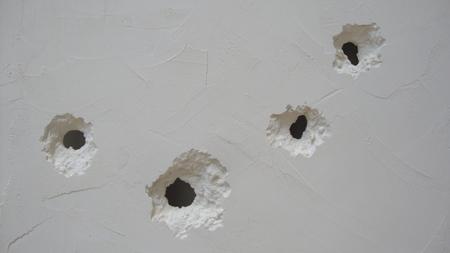Taliban Relief Paintings and Crude Oil Silk Screens is a major exhibition of new works by Piers Secunda. The exhibition runs until 24 December at the Aubin Gallery and will feature works created by the most potent human acts of all time, presented in unique and remarkable forms.
Secunda's distinct studio practice has pushed the development of paint as a fully operational sculptural material for fifteen years. The works in this exhibition reveal a progressive and dynamic new direction, presented through a striking geo-political texture: sheets of paint shot by the Chinese army in 2009, and more recently casts formed out of real Taliban bullet holes, and the results of suicide bomb attack sites in Afghanistan.
In August 2010, Secunda flew to Kabul with the sole intention of specifically casting Taliban bullet holes. Two suicide bomb attack sites were located in advance and existing bullet holes were confirmed as Taliban by witnesses and the Kabul police.
The first site was an attack on a private security firm in a residential area of Kabul. At the outset of the Taliban's assault on the building, two drivers for the security firm were fatally shot inside their car. The works in this exhibition were created directly from casts of bullet holes made as members of the Taliban shot through and around the car - killing the drivers and pock-marking the wall behind.
Over the last three years a separate and parallel practice has developed in Secunda's work: painting and printing in crude oil. Born from an understanding that crude oil facilitates everything we do in the western world, Secunda has developed the necessary techniques to make crude oil behave as paint. The crude oil prints in this exhibition show early oil discoveries, made using crude oil from the very areas portrayed.
Secunda's two practices - the casting of bullet holes and the use of crude oil as paint - therefore run in parallel. One derived from a modernist discourse, the other from a raw material not conventionally viewed as an artistic tool. Both are visual vehicles for powerful messages, recording some of the potent human activities of our time.







